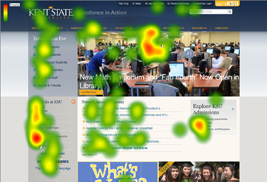Featured Article
Kent State University Regional Academic Center Students Blog About Sept. 11 Anniversary
In commemoration of the 10th anniversary of the Sept. 11 attacks, students at the Kent State University Regional Academic Center in Twinsburg, who were only about 10 years old at the time, are speaking on the events as part of their Media, Power and Culture class.
read moreKent State’s ScanPath Lab Helps Real-World Clients With Website Usability Challenges
Posted Sept. 19, 2011 | Sarah Lack
The ScanPath Lab provides research and consulting
services to improve user experience and website usability.
Aaron Rosenberg spends much of his time at Kent State University’s ScanPath usability lab analyzing screen shots of websites with heat maps and detailed eye tracking charts, which look like a maze of lines connected by different sized polka dots.
ScanPath is a small business initiative of the Information Architecture and Knowledge Management program in the School of Library and Information Science.The entrepreneurial start-up provides research and consulting services to help clients improve user experience and usability on their websites.
“I saw a local need for usability research,” ScanPath manager Rosenberg says. “I presented a proposal to Kent State to use the eye-tracking equipment as another revenue stream for the university. I wanted to take advantage of the equipment and existing infrastructure already in place.”
While the School of Library and Information Science Usability Lab in the University Library was started almost seven years ago for educational purposes, Rosenberg developed the new business model for ScanPath and launched it four years ago after leaving his job as a user experience product analyst at American Greetings.
Last year, ScanPath relocated to The Tannery and began a partnership with the student-run integrated marketing and communications firm.
“Since partnering with ScanPath, we’re in a better position to help clients with modern communications challenges,” says Evan Bailey, operations manager at The Tannery. “It was two separate business models that came together to provide both educational and business opportunities.”
ScanPath uses the Tobii eye-tracking system, which follows a user’s eye movements as they navigate through a website. The program maps out the way eyes glide over a website, with different sized dots signifying the amount of time the eyes linger on a point on the page.
Rosenberg says there are few companies in the area that can provide this kind of service to clients. As a result, ScanPath has worked with high-profile local companies like Sherwin-Williams and Little Tikes. In addition, ScanPath regularly does work for advertising and integrated agencies who subcontract projects involving Web usability.
“The type of work and our expertise in the area make sense for large companies,” Rosenberg says. “They see a quicker return on investment and more benefits in the long run. Specializing to find partnerships allows us to find new ways to work that solve big client problems.”
Many times, companies aren’t aware of the high-tech usability research available to them locally.
“We’re providing capabilities they don’t really know they need,” says Dawn Burngasser, Rosenberg’s assistant and a graduate student in the Information Architecture program at Kent State.
When Rosenberg and Burngasser begin working with a client, they conduct usability studies with volunteers who navigate a website to complete a series of tasks.
“When you actually sit someone down in front of a website, you have to think about language, navigation, images and text,” Rosenberg says. “We try to understand the thought process by watching what people are actually doing, and then give our clients actionable results to make changes.”
However, the impact of a well-designed and easily navigated website is undervalued by most companies.
“What we provide is an understanding about how to get the most out of the people that use your site,” Rosenberg says. “With a website design background, we then suggest how to make the site better by using the same technology.”
Conducting web usability studies involve a combination of technology and psychology.
“Usability studies look simple, but you have to know to ask the right questions and remove all bias,” Burngasser says. “Sometimes the eye tracking software shows something different than what people actually do. We have the data to back that up.”
For more information about ScanPath, visit the School of Library and Information Science website.
